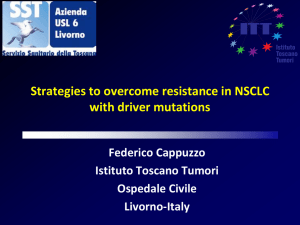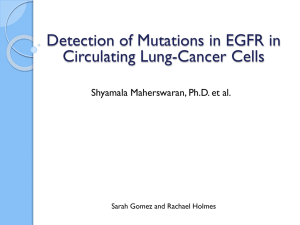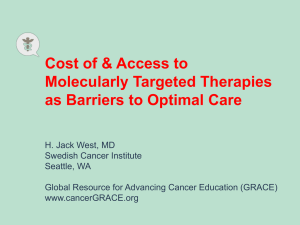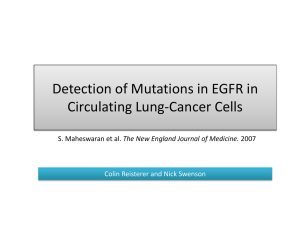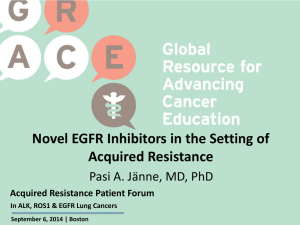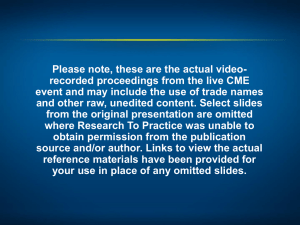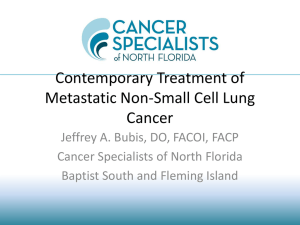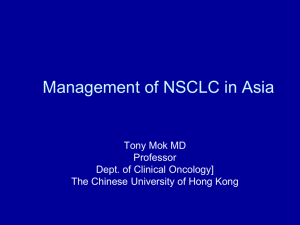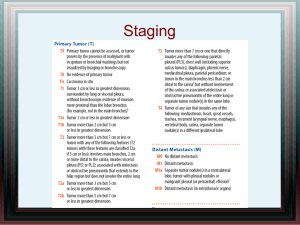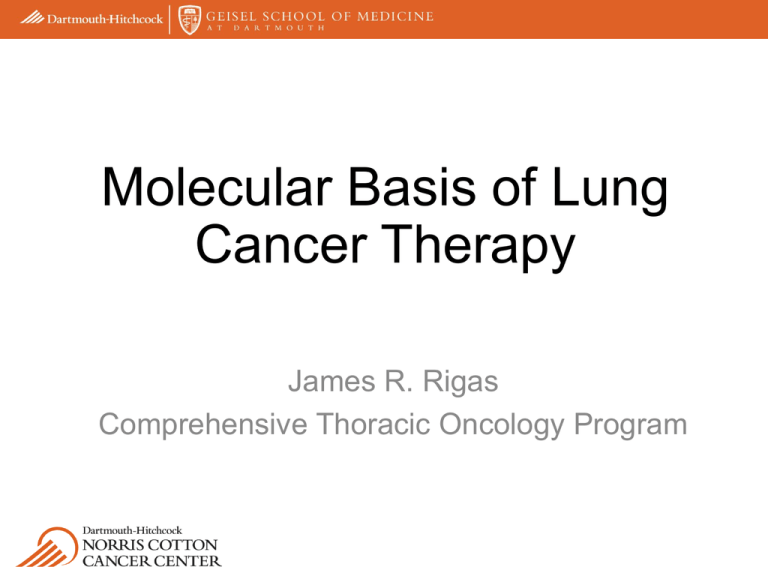
Molecular Basis of Lung
Cancer Therapy
James R. Rigas
Comprehensive Thoracic Oncology Program
Traditional View of Lung Cancer
Small
Cell
Large Cell
Adenoca
Squamous
Presentation
• EGFR mutations
– RADIANT adjuvant results in EGFR mutations
– Uncommon EGFR mutations
– Resistance in EGFR mutations (+) patients
• ALK gene rearrangements
– Resistance in ALK gene rearrangement (+) patients
• BRAF mutations
• Other mutations, fusions and amplifications
Locations and Types of the 134 EGFR Gene Mutations
Detected in Lung Cancers
Del 19
T790M
L858R
Shigematsu H et al. JNCI J Natl Cancer Inst 2005;97:339-346
Journal of the National Cancer Institute, Vol. 97, No. 5, © Oxford University Press 2005, all rights reserved.
EURTAC Study Design
Stage IIIB/IV NSCLC
EGFR exon 19 deletion or
exon 21 L858R mutation
(DNA sequencing/Genescan
and Taqman)
Chemonaive
ECOG PS 0–2
Measurable or evaluable
disease
Primary endpoint
• Progression-free survival (PFS)
US FDA approval May 14, 2013
Cobas® EGFR Mutation Test
41 mutations in Exons 18, 19, 20 and 21
Erlotinib 150 mg/day
R
PD
Stratification
• Mutation type
• ECOG PS (0 vs 1 vs 2)
Platinum-based doublet
chemotherapy q3wks
x 4 cycles*
Secondary endpoints
• Objective response rate
• Overall survival (OS)
• Location of progression
• Safety
• EGFR mutation analysis in serum
• Quality of life
ECOG = Eastern Cooperative Oncology Group; PS = performance status; PD = progressive disease
*Cisplatin 75mg/m2 d1 / docetaxel 75mg/m2 d1; cisplatin 75mg/m2 d1 / gemcitabine 1250mg/m2 d1,8;
carboplatin AUC6 d1 / docetaxel 75mg/m2 d1; carboplatin AUC5 d1 / gemcitabine 1000mg/m2 d1,8
PD
Primary endpoint: PFS in ITT population
(updated analysis 26 Jan 2011)
1.0
Erlotinib (n=86)
Chemotherapy (n=87)
PFS probability
0.8
HR=0.37 (0.25–0.54)
0.6
Log-rank p<0.0001
0.4
0.2
5.2
0
0
9.7
3
6
9
12
63
49
54
20
32
8
21
5
15
18
Time (months)
21
24
27
30
33
7
1
4
0
2
0
2
0
0
0
Patients at risk
Erlotinib
Chemo
86
87
17
4
9
3
Data cut-off: 26 Jan 2011
US FDA approval May 14, 2013
Study design
Stage IIIB (wet)/IV lung adenocarcinoma (AJCC version 6)
EGFR mutation in tumor
(central lab testing; Therascreen EGFR29* RGQ PCR)
Randomization 2:1
Stratified by:
EGFR mutation (Del19/L858R/other)
Race (Asian/non-Asian)
Afatinib 40
mg/day†
Cisplatin + Pemetrexed
75 mg/m2 + 500 mg/m2
i.v. q21 days, up to 6 cycles
Primary endpoint: PFS (RECIST 1.1, independent review)‡
Secondary endpoints: ORR, DCR, DoR, tumor shrinkage, OS, PRO§, safety, PK
*EGFR29:19 deletions in exon 19, 3 insertions in exon 20, L858R, L861Q, T790M, G719S, G719A and G719C (or G719X), S768I.
†Dose escalated to 50 mg if limited AE observed in cycle 1. Dose reduced by 10 mg decrements in case of related G3 or prolonged G2 AE.
‡Tumor assessments: q6 weeks until Week 48 and q12 weeks thereafter until progression/start of new therapy.
§Patient-reported outcomes: Q-5D, EORTC QLQ-C30 and QLQ-LC13 at randomization and q3 weeks until progression or new anti-cancer therapy.
US FDA approval July 12, 2013
Yang JC, et al.
EGFR Gene Mutations in Adenocarcinoma Lung Cancer
1% 1%
2%
3% 2%
0% 1%
1% 0%
0%
n = 345
40%
49%
N=138
N=170
Del 19
89%
L858R
Exon 20 ins
L858R + T790M
L861Q
G719X
Del19 + T790M
T790M
L858R + S768I
G719X + S768I
G719X + T790M
S768I
Therascreen ®
EGFR (29) RGQ PCR Kit
PFS: Common mutations (Del19/L858R)
Independent review – patients with Del19/L858R (n=308)
Progression-free survival (probability)
1.0
Afatinib
n=204
Cis/pem
n=104
PFS event, n (%) 130 (64)
0.8
Median PFS (months)
13.6
Hazard ratio
(95% confidence interval)
0.6
61 (59)
6.9
0.47 (0.34–0.65)
p<0.0001
51%
0.4
0.2
21%
0.0
0
Number at risk
Afatinib
204
Cis/Pem
104
3
6
169
62
143
35
US FDA approval July 12, 2013
9
12
15
18
Progression-free survival (months)
115
17
75
9
49
6
Yang JC, et al.
30
2
21
24
27
10
2
3
0
0
0
RADIANT Study Schematic
P a tie n ts w ith S ta g e IB -IIIA N S C L C
T u m o r T is s u e
A n a ly s is
EG FRN e g a tiv e
b y b o th
IH C a n d
F IS H
In e lig ib le
C o m p le te S u rg ic a l R e s e c tio n
S c re e n in g C o n s e n t
EG FRP o s itiv e
b y IH C
a n d /o r
F IS H
N o C h e m o th e ra p y o r U p to 4 C y c le s o f a S ta n d a rd
(n o n -in v e s tig a tio n a l), P la tin u m -b a s e d , A d ju v a n t
C h e m o th e ra p y R e g im e n
T re a tm e n t C o n s e n t
R a n d o m iz a tio n (2 :1 )
1 5 0 m g /d a y T a rc e v a
P la c e b o
2 y rs o r u n til o n e o f th e fo llo w in g :
re la p s e , d e a th , p a tie n t re q u e s t o r
in v e s tig a to r d e c is io n to
d is c o n tin u e s tu d y d ru g th e ra p y , o r
in to le ra b le to x ic ity
F o llo w -u p V is it O n c e E v e r y 6 M o n th s fo r U p
to 5 Y e a rs a fte r R a n d o m iz a tio n , th e n Y e a rly
RADIANT Study Results
Hierarchical testing rendered all
secondary endpoints non-significant.
LUX-Lung clinical trials and eligibility
2
LUX-Lung 2
LUX-Lung 3
LUX-Lung 6
Phase II
Phase III
Phase III
N=129
N=345
N=364
Treatment
Afatinib
Afatinib vs.
Pemetrexed/
cisplatin
Afatinib vs.
Gemcitabine/
cisplatin
Line of
treatment
First- and
second-line
(after chemo)
First-line
First-line
Mutation
test
Direct
sequencing
(central)
EGFR29*
(central)
EGFR29*
(central)
*EGFR mutations detected by TheraScreen EGFR29 test:
– Common: 19 deletions in exon 19 and L858R in exon 21
– Uncommon: 3 insertions in exon 20, L861Q, T790M, G719S, G719A and G719C, S768I
EGFR mutation-positive patients in LUX-Lung trials
3
LUX-Lung 2
LUX-Lung 3
LUX-Lung 6
Phase II
Phase III
Phase III
N=129
N=345
N=364
Del19
n=408
n=52
n=170
n=186
L858R
n=330
n=54
n=138
n=138
Uncommon
n=100
n=23
n=37
n=40
Patients with uncommon mutations treated with afatinib
Uncommon
n=75
n=23
n=26
n=26
Subgroups of patients with uncommon mutations
5
Categories
n=
Mutations
(n)
De novo
T790M
Exon 20
insertions
Other
(exon 18, 19, 20, 21)
14
23
38
T790M alone (3)
T790M+Del19 (3)
T790M+L858R (6)
T790M+G719X (1)
T790M+L858R+G719X (1)
n/a
L861Q alone (12)
G719X alone (8)
G719X+S768I (5)
G719X+L861Q (3)
E709G or V+L858R (2)
S768I+L858R (2)
S768I alone (1)
L861P alone (1)
P848L alone (1)
R776H+L858R (1)
L861Q+Del19 (1)
K739_1744dup6 (1)
Tumour shrinkage in patients with uncommon mutations
Independent review (n=67†)
120
*
7
De novo T790M (n=14):
T790M alone(*), T790M+Del19, T790M+L858R, T790M+G719X, T790M+L858R+G719X
Maximum change from baseline (%)
100
Exon 20 insertions (n=20)
Other (n=33):
80
L861Q, G719X, G719X+S768I, G719X+L861Q, E709G or V+L858R, S768I+L858R,
S768I, L861P, P848L, R776H+L858R, L861Q+Del19, K739_1744dup6
60
40
20
0
*
*
-20
-40
-60
-80
-100
†8
patients were not included due to insufficient data
T790M+ EGFR- TKI failures 2nd/3rd line NSCLC
An area of high unmet medical need
There are no current proven treatment options for these patients.
Chemotherapy or EGFR-TKIs are used, but their benefit isn’t proven
EGFR TKI
resistance
mechanisms
AZD9291 or
CO1686
“Patients with EGFR-mutant lung adenocarcinoma develop acquired resistance to
EGFR tyrosine kinase inhibitors (TKIs) after a median of 10-16 months. In half of
these cases, a second EGFR mutation, T790M, underlies acquired resistance”
Oxnard, et al. Clin Cancer Res Dec 6, 2010
Clinical activity AZD9291 in T790M+
Fast Track status granted by FDA in October 2013
Breakthrough Therapy Designation submission early February 2014
Best % change from baseline in target lesions in central testing T790M+
T790M+ Response Rate* = 64% (95% CI 53%-74%)
For the 89 T790M+ evaluable patients there are
57 PRs (35 confirmed), 28 SDs, 4 PDs
Population:
T790M+ patients
with observed or
imputed target
lesion data (n=89)
*Confirmed+
unconfirmed
response
Response ongoing for 34/35 T790M+ patients with
confirmed PR
D Discontinued treatment
* Imputed
T790M status is assigned by central testing of a recent tumour sample
Independent review of scans is underway as per FDA request 41/43 confirmed so far
Preliminary data, data cut off
16th January 2014
CO1686
FISH Assay for ALK Rearrangement*
p25.2
p25.2
p24.3
p24.1
p23.2
p22.3
p22.1
p16.3
ALK 29.3
p24.3
EML4 42.3
p16.3
Telomere
2p23 region
p24.1
p23.2
p22.3
p22.1
p16.1
p16.1
p14
p13.2
p14
p13.2
p12
p12
q12.1
q12.3
q12.1
q12.3
q14.1
q14.1
q14.3
q21.2
q14.3
q21.2
q22.1
q22.2
q23.2
q22.1
q22.2
q23.2
q24.1
q24.1
q24.3
q24.3
q31.3
q31.3
q32.1
q32.1
q32.3
q32.3
q33.2
q33.2
q34
q34
q36.1
q36.3
q37.2
q36.1
q36.3
q37.2
Centromere
t(2;5) ALK gene
breakpoint region
3’
5’
~250 kb
~300 kb
Break-apart FISH assay
for ALK-fusion genes1
Non-split signal
Split signal
ALK break-apart FISH assay
[Courtesy John Iafrate, Massachusetts General Hospital]
*Assay is positive if rearrangements can be detected in ≥15% of cells
FISH = fluorescence in situ hybridization
1Shaw
AT et al. J Clin Oncol
2009;27:4247–4253
Crizotinib: First-in-human/Patient Trial
Cohort 5 (n=6)
2 DLTs: grade 3 fatigue
300 mg BID
Part 1:
Dose escalation
Cohort 6 (n=9)
Cohort 4 (n=7)
250 mg BID
MTD/RP2D
200 mg BID
Cohort 3 (n=8)
1 DLT: grade 3 ALT
elevation
200 mg QD
Cohort 2 (n=4)
100 mg QD
Cohort 1 (n=3)
50 mg QD
ALT = alanine aminotransferase
Part 2:
Molecularly enriched cohorts
(ALK and c-MET)
Enrolling patients with ALK-positive NSCLC
after preliminary observation of impressive
activity in a few patients
• Data from database April 7, 2010
• Data presented for 82 patients, study
ongoing
Tumor Responses to Crizotinib for Patients
with ALK-positive NSCLC
Maximum change in tumor size (%)
60
Progressive disease
Stable disease
40
Confirmed partial response
Confirmed complete response
20
0
–20
–30%
–40
–60
–80
–100
US FDA accelerated approval Aug 26, 2011
Full approval Nov 21, 2013
*
*Partial response patients with 100% change have non-target disease present
U
Expansion
Phase
NCT01283516
Advanced ALK-rearranged malignancies
Completed
n=59
Dose escalation started at 50 mg/day
Escalate to MTD (750 mg/day)
ALK-rearranged NSCLC
Additional
n=71
enrolled
Crizotinib
naive
Crizotinib
pretreated
Other
ALKactivated
tumors
Primary objective: determination of MTD
Secondary objectives: characterize safety, PK, and antitumor activity
Patients received treatment until disease progression, unacceptable toxicity, or
withdrawal of consent
Continuous oral dosing
21-day cycles
Dose-Escalation
Phase
Study Design – LDK378 (Ceritinib)
Shaw AT et al. N Engl J Med. 2014;370:1189-1197.
Expires April 2015
MED.ONC.LDK.U.EISEX
25
U
Best Change (%) in Tumor Response from
Baseline in NSCLC Patients Treated with Ceritinib
Best Change (%) from Baseline
100
Crizotinib Pretreated
Crizotinib Naive
PFS Event
80
60
40
20
0
-20
-40
-60
-80
US FDA accelerated approval Apr 30, 2014
-100
Based on investigator assessment of response.
PFS, progression-free survival.
Shaw AT et al. N Engl J Med. 2014;370:1189-1197.
From N Engl J Med, Shaw AT, Kim DW, Mehra R, et al, Ceritinib in ALK-Rearranged Non–Small-Cell Lung Cancer, Vol 370, Page 1194.
Copyright © 2014 Massachusetts Medical Society. Reprinted with permission from Massachusetts Medical Society.
Expires April 2015
MED.ONC.LDK.U.EISEX
26
BRAF-Mutations in NSCLC
W. Pao, N. Girard
Lancet Oncology,
February 2011
A. Marchetti et al., J. Clin. Oncol. 29, 1, 2011
• 1,046 NSCLC samples
• Frequency of BRAF-mutations 3.5%
• BRAF-mut. in 4.9% adeno- and 0.3% SCC
• 57% BRAFV600E-mutations
• 43 % non-activating BRAF mutations
P. Paik et al., J. Clin. Oncol. 29, 2046, 2011
• 697 NSCLC-adeno. ca. Samples
• Frequency of BRAF-mutations 3%
1.5-2.5 % of NSCLC
harbor BRAF V600E-mutations
• 50% BRAFV600E-mutations
• 50% non-activating BRAF mutations
BRF113928: Initial Study Design
• Single arm, Phase II, open label
• Green-Dahlberg 2-stage: H(0): ORR ≤ 10% versus H(1): ORR ≥30%
Primary objective: Investigator-assessed ORR
NSCLC
(Adenocarcinoama)
BRAFV600Emutation
N = 40
dabrafenib
150 mg twice
daily
≥ 2nd Line
Secondary objectives: PFS, duration of response, OS,
safety and tolerability, population PK
Interim Analysis (ASCO 2013)
US FDA granted Breakthrough
Therapy Jan 13, 2014
Investigator based response assessments demonstrated:
7PRs (5 confirmed—duration 29 and 49 weeks for 2 pts and
remaining 3 patient 6+ to 24+ weeks)
1 stable disease
4 progressive disease
Planchard et. al. 2013 ASCO Annual Meeting Proceedings
Rationale for the Combination
Sustained target inhibition Delay and potentially
to observe more prolonged prevent the development of
and durable anti-tumor
resistance
effect
RAS
BRAFi
mutBRAF
+
MEKi
MEK
pERK
Proliferation, survival
Invasion , Metastasis
Prevent/delay
hyperproliferative lesions
and secondary
malignancies (Cu SCC)
BRAF V600
BRAF WT
Molecular Subsets
Adenocarcinoma Lung Cancer
NRAS
MAP2K1
ROS1 fusions
AKT1
KIF5B-RET
PIK3CA
BRAF
HER2
ALK
Fusions
Unknown
EGFR
KRAS
1. Mascaux C et al. Br J Cancer 2005;92:131–9; 2. Winton et al. N Engl J Med 2005;352:2589–97; 3. Eberhard et al JCO 2005;23:5900–9;
4. Pao et al. PLOS Medicine 2005 2(1): e17; 5. Pao et al. Nat Med 2012;18:349–51; 6. Kris et al. ASCO 2011
Structural variants
•
•
•
Translocations
Fusions
Inversion
Copy number
alterations
•
•
•
Amplifications
Deletions
LOH
Point mutations &
indels
•
•
•
•
Missense
Nonsense
Splice site
Frameshift
Gene expression
•
•
•
Outlier expression
Isoform usage
Pathways & signatures
Wild type AGTGA
Mutant
AGAGA
Adapted from: Roychowdhury et al. Sci Transl Med; 20122
32
Conclusion
• Molecular selection of patients improves therapy outcomes
for patients with advanced adenocarcinoma of the lung
Future Directions
• Extent patient selection and targeted therapies to squamous
cell and earlier stages of NSCLC (i.e. RADIANT)
• Next generation sequencing needed
• Molecular characterization of resistance
• Development of a structure to conduct studies in uncommon
molecular selected populations (BRAF, HER2, RET, etc)
• Clinical integration of tumor genomic and proteomic testing to
better direct therapy for NSCLC (Gerber)

